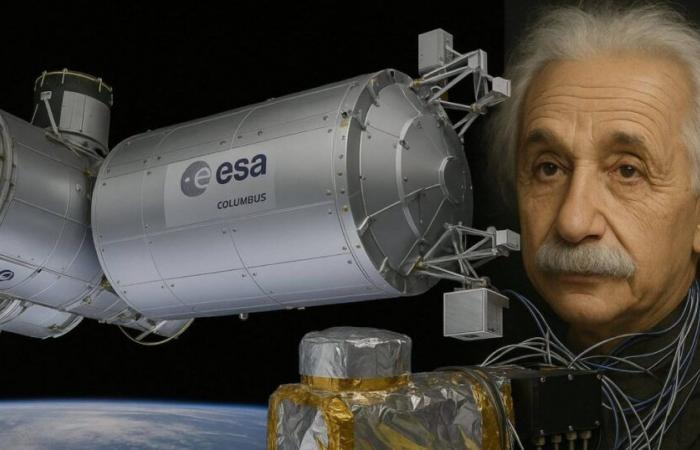Created: 2.05.2025 | 11:13 Updated: 2.05.2025 | 11:13
Most of us may not think about watches beyond reaching a timely meeting. But for those who work in fundamental physics, time is an absolute precision tool, and measuring it exactly is one of the most direct ways of understanding the laws of the universe. Now, the European space Agency (ESA), in collaboration with NASA, has taken this goal to new heights. Literally. The project ACES (Atomic Clock Ensemble in Space) It is already in orbit, installed in the Columbus module of the International Space Station (EEI), with the ambitious mission of synchronizing the most precise watches of the planet … from space.
The funny thing is that this story began more than three decades ago with a clock that occupied an entire room in the Paris Observatory. Today, that giant has become an instrument of the size of a refrigerator and has traveled more than 400 kilometers over our heads. ACES combines the most advanced technology in atomic watches with a communication network by microwave and laser to verify theories of more than a century ago and perhaps redefine how we measure the second. As Thomas PEignier, the main engineer of the project explained: “ACES is an extremely sensitive system, composed of intricate and interconnected subsystems that must work in harmony”.
A European mission with global ambition
ACES is a completely European missionalthough with a clear international dimension. The design, manufacture and assembly were carried out in different countries of the continent. The Pharao clock was developed by CNES in France, and the SHM by Safran Timing Technologies in Switzerland. The time transfer system was designed by the German company Timetech, while Airbus in Friedrichshafen was responsible for integrating the whole. All this was coordinated by ESA, which also directs the scientific operation from two centers: Cadmos in Toulouse and the Columbus Control Center in Germany.
The launch took place on April 21, 2025 from the Kennedy Space Center, in a Spacex Dragon capsule. Only four days later, on April 25, a robotic arm from the EEI installed ACES on the outside of the Columbus module. Since then, The experiment remains exposed to space vacuumfunctioning autonomously while establishing temporary connections with land stations when different regions flies. This design allows comparing watches distributed by the planet with a precision that was previously unattainable.

What is really an atomic clock?
And Atomic clock It is a device that measures time by observing the oscillations of atoms, instead of using pendulums or gears such as traditional watches. These oscillations – transitions between energy levels in atoms – occur at extremely stable frequencies, allowing unprecedented precision. For example, Cesio watches have 9 192 631 770 oscillations of the atom to define a second.
The idea of using matter as a time reference is not new. Was William Thomson, better known as Lord Kelvinwho in the nineteenth century proposed that atomic vibrations could serve as an ideal basis to measure time, being constant by nature. Today, that intuition has become the basis of our most advanced timing.

Pharao and SHM: two watches, a single signal
In the heart of the experiment they are found Two atomic watches with complementary functions. Pharao is a laser -cooled cesium atom watch, the first of this type to operate in space. In the microgravity of the Earth’s orbit, the atoms can move more slowly and remain in a longer state, which allows extremely precise frequency measurements. Laser cooling reduces the speed of atoms almost until they are stopped, a condition that can only be achieved in vacuum chambers of several meters high.
On the other hand, the SHM is an active hydrogen masser, capable of generating a reference signal without depending on an external stimulus. This gives it exceptional stability in short time scales, which makes it the perfect complement to Pharao. While one provides long -term stability, the other does it in shorter intervals. Together, they can maintain such a precise sign that I would only lose a second in 300 million years.

An orbital laboratory to test theories
One of Ace’s main scientific objectives is to verify more precision how gravity affects the passage of time, as predicts the general theory of Albert Einstein’s relativity. This theory states that The greater the gravity, the more slowly the time takes place. It has already been proven in experiments on Earth, for example, measuring differences between watches located at the top of a mountain and sea level. But now, with ACES operating 400 kilometers of altitude, these measurements are expected to reach a precision ten times higher than the previous ones.
To achieve this, ACES uses two types of links to compare their watches with those of the Earth. On the one hand, a microwave connection, with terminals installed in Europe, Japan, the United States and the United Kingdom. On the other, a laser optical system known as European Laser Timing (ELT)which emits pulses towards space from terrestrial observatories and measures the echo reflected by the orbital equipment. Thanks to both methods, the effects of the atmosphere and the space environment can be compensated, and achieve time comparisons at the level of Milmillonés de Segundo.

Much more than measuring seconds
ACES’s potential is not limited to trying theories of the twentieth century. It can also contribute to the redefinition of the second, the basic time unit in the international system. Currently, the second is based on the oscillation frequency of Cesium atoms, such as those used in Pharao. However, new generation optical watches, which are already being developed in several laboratories, are even more stable. ACES allows them to compare them with each other through their global networkpaving the way for a possible future redefinition of time.
In addition, the extreme precision of the system has applications in other areas of science. In geodesy, it can help detect gravitational potential differences between different points of the planet, that is, to measure more precision the form and variations of the gravitational field of the Earth. It can also be used to study whether the fundamental constants of physics, such as the speed of light or Planck’s constant, change over time. There is even the possibility of seeking indirect signs of dark matter, one of the great unknowns of current physics.
A network for the future of time
Thanks to its bond technologies for microwave and laser, ACES can synchronize watches in different parts of the world with unprecedented precision. This not only improves the quality of scientific experiments, but also It has practical implications: Global positioning systems, such as GPS or Galileo, depend on atomic watches to function properly. Improving the accuracy of these watches can translate into greater accuracy for navigation, transport or telecommunications.
The experiment also has a structural component that allows its update. The Modular Architecture of ACES admits the incorporation of new technologies in the future, such as Optical watches in future missions. In fact, one of the goals of the program is precisely to rehearse the infrastructure for what could become a planetary network of quantum watches synchronized through space. As Luigi Cacciapuoti, project scientist indicated: “Aces responds today to an urgent need for the scientific community and will surely play a key role in the redefinition of the time unit”.
References
- Marie Deschamps. 7 things you didn’t know about ACES. ESA – Exploration. 2025.
Marie Deschamps. The clocks of ACES. ESA – Exploration. 2025.
ESA. ACES: Atomic Clock Ensemble in Space. ESA – Science & Exploration. 2025.
ESA. ACES heading to its orbit: Ultra -Precise European atomic watches reach space. ESA. 2025.
ESA. ACES Factsheet. That multimedia. https://doi.org/10.5270/esa-aces-factsheet-2025







